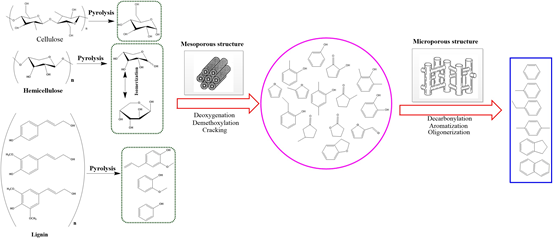(383e) Effect of HZSM-5 Zeolite Treated with Tpaoh on the Production of Aromatic Hydrocarbons from Microwave Assisted Catalytic Fast Pyrolysis (MACFP) of Rice Husk
AIChE Annual Meeting
2020
2020 Virtual AIChE Annual Meeting
Catalysis and Reaction Engineering Division
Pyrolysis of Biomass
Tuesday, November 17, 2020 - 9:00am to 9:15am
We performed microwave-assisted catalytic fast pyrolysis (MACFP) of rice husk (RH) over an alkali-treated HZSM-5 zeolite, for production of hydrocarbons. The treatment consisted in the modification of the HZSM-5 by the organic base tetrapropylammonium hydroxide (TPAOH) solution at several concentrations. We characterized the resulting catalysts by powder X-ray diffraction (XRD), transmission electron microscopy (TEM), N2 adsorption-desorption, and temperature-programmed sorption of ammonia (NH3-TPD). The results suggest that the TPAOH treatment generated mesoporous structures in the HZSM-5, while preserving its microporous structure and crystallinity. We obtained the highest yield (45.9%) of hydrocarbons from MACFP of rice husk (RH) at 550°C. As the TPAOH concentration increases, the relative content of BTEX hydrocarbons (benzene, toluene, ethylbenzene, and xylene) reaches a maximum value of 22.9% at 2.0 mol/L. A comparison of results obtained over the organic base TPAOH (HZSM-5 modified by 2.0 mol/L TPAOH solution) with those obtained over an inorganic base (HZSM-5 modified by 2.0 mol/L NaOH solution) shows a 4.3 % increase in the relative content of monocyclic aromatic hydrocarbons for the TPAOH. In addition, the TPAOH-treated catalyst shows excellent selectivity of BTEX (58.5%), which is higher than the selectivity obtained with the parent HZSM-5 (51.2%) and NaOH-treated HZSM-5 (53.9%). The TPAOH-modified HZSM-5 catalyst effectively reduced coke formation by 4.6 % compared to MACFP over the parent HZSM-5, most likely because TPAOH decreases the concentration of strong acidic sites on the outer surface of the catalyst, creating a mesoporous structure while retaining the weak acidic sites on the HZSM-5 inner surface.
The new catalyst generated in this work contains a moderate amount of mesopores structures, which allows for effective upgrading of pyrolysis vapors while simultaneously reducing coke formation, thereby addressing a significant problem in the development of the catalytic fast pyrolysis process.
